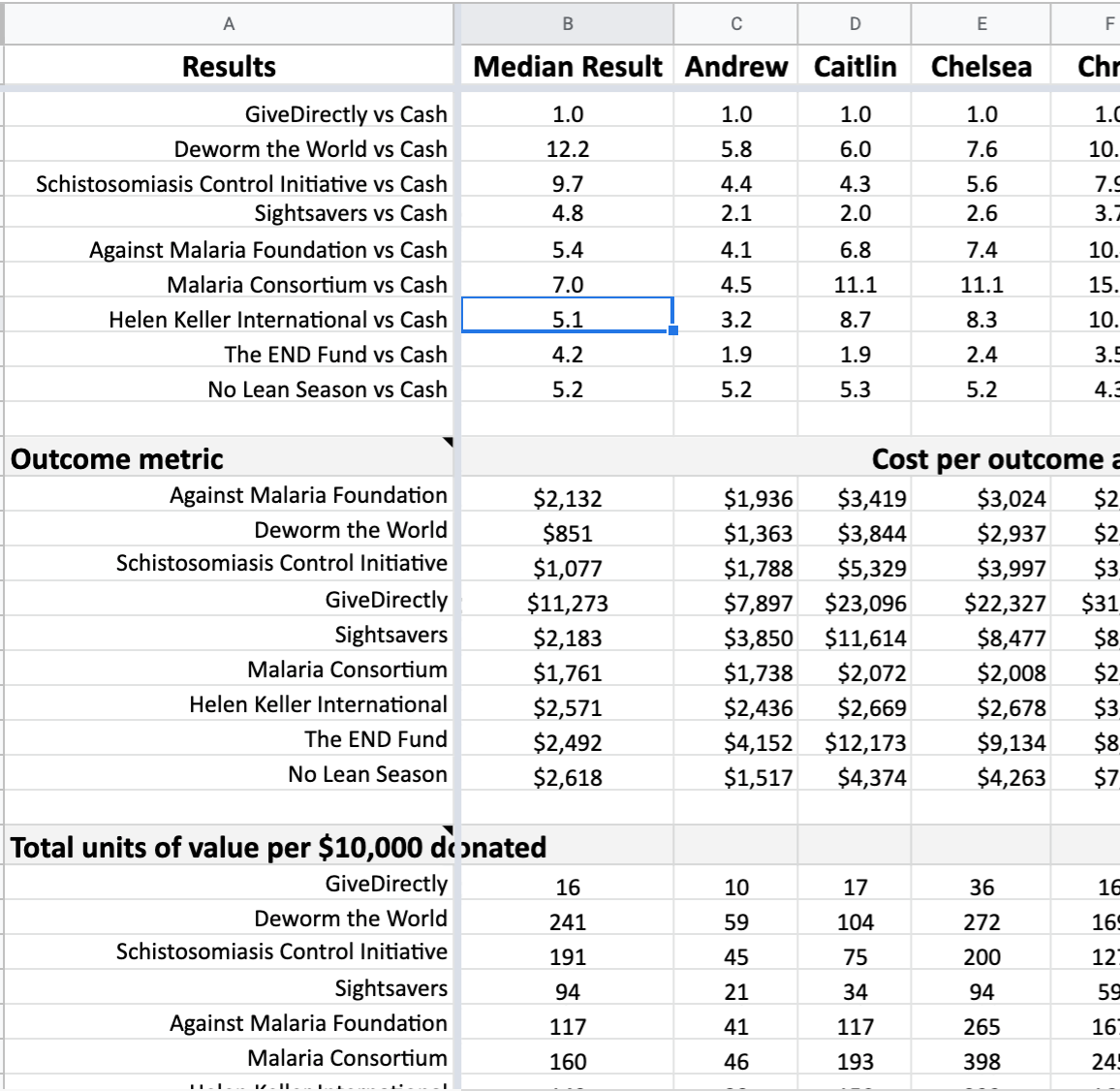1 Introduction: Effective giving, responses to analytical ‘effectiveness information’
This project aims to robustly measure and synthesize evidence about how charitable giving responds to the presentation of analytical ‘impact per dollar’ information.
Why do we care about this? From our academic-style abstract:
While hundreds of billions of dollars are donated to charity each year, the effectiveness of these charities differs by orders of magnitude, even within similar categories. Furthermore, many individuals do not donate substantially even though they believe that the cost of saving a life is small. Our collaborative and dynamic synthesis considers this ‘puzzle’.
For people to systematically choose the most efficient charities they must be aware of the differences in effectiveness, suggesting a role for advertising and publicity. The EA movement and organizations like GiveWell and SoGive are increasingly presenting these to larger and more mainstream settings. However, we have limited evidence on how potential donors react to quantitative measures of charitable impact. We survey and meta-analyze this evidence below, also incorporating ‘our new evidence’.
Charity Navigator’s use of Impact Matters data might be considered an impact megasure, but so far, it has not been used prominently, nor in a way that allows meaningful comparisons. See discussion here
There is a puzzle: people make inefficient giving choices, and give little to highest-impact causes*
*See “Presenting the puzzle” in Increasing effective charitable giving web-book/ That work offers a Conceptual breakdown of ‘barriers’
It has been claimed1 that ‘innumerate empathy’ is a key barrier to promoting effective giving. Previous work2 concludes that emotional reactions to suffering leads to helping behavior, but this ’doesn’t scale’ with need, and few people actually ‘research effectiveness before giving’. In a ‘dual process’ model of cognition, analytical impact information may disrupt empathic giving.
Here, we are analysing a variety of giving experiments, across various contexts.
Preliminary suggestive results: Analytical info doesn’t seem to substantially disrupt emotional-empathic giving (but there may still be a lack of power to detect small effects), and may enhance it. There seem to be heterogeneous effects by type of donor (Karlan), but this needs further examination (as it’s an ex-post hypothesis). The ‘right’ empathic images can drive effective giving. In less precise comparisons, overstated analytical effectiveness information seems to boost giving, at least relative to more realistic effectiveness information.
Unfold for a further discussion (from (Bergh and Reinstein 2020) abstract)
A small share of charitable giving goes towards “highly-effective” charities as measured by GiveWell (or to charities in this category: health interventions in poor countries).
Previous work finds that helping behaviors are strongly driven by emotional reactions to individual suffering, but these do not scale with the magnitude of need. From a dual-process perspective, presenting analytical impact information may even disrupt empathic giving, shifting potential donors towards a system-II deliberative mode. We report on seven charitable giving experiments. Treatments (between subjects, mainly 2x2) present (i) measures of charity efficiency/effectiveness and (ii) empathy-inducing images. Variations across experiments include: subject pools (MTurk, UK students, US regular donors via direct mail), separate vs. joint evaluation, the nature of the effectiveness information, and treatment ordering/timing.
1.1 Definition of ‘effective giving’ for our purposes, motivation*
Please see Definitions - “Efficiency” versus impact from ‘Barriers’ web book for a more in-depth presentation of this.
We define the impact, also referred to as the effectiveness of a charity, as follows:
\(B(G_i)\): The beneficial outcome achieved by charity \(i\) with total donations \(G_i\)
This is an ultimate outcomeL Lives saved, QALY added, etc.
We are not referring to intermediate ‘outputs’ such as ‘nets provided’ nor ‘paintings purchased’
(Total or marginal) impact per dollar = output per dollar \(\times\) impact per output
Steinberg & Morris, 2010 wrote about marginal vs average effectiveness.
:::
Impact of a donation:
\(B'(G_i)\) for the marginal donor
- GiveWell and others attempt to measure this
We have a strong empirical case that (in-depth discussion here):**
\(B'(G_i)\) is much larger for most impactful vs. most popular charities.
1.2 Raises questions
- “Why don’t we give more to the most effective charities and to those most in need?”,
and
- “Why are we not more efficient with our giving choices?”
Is this a ‘Puzzle’?
1.3 Barriers and the use of analytical effectiveness information
We give a breakdown and assesment of potential barriers to effective giving in the aforementioned ‘barriers’ book.
Unfold for a peek at our proposed definitions:
Psychological distance/emotional arousal: Whether a cause/charity is something people are aware of, feel is important/salient, and feel close to
Identity: Things that run against one’s self-perception and how one believes others will will see you. (e.g., signaling emotional empathy; avoiding cognitive dissonance from previous ineffective giving)
Inertia and systemic/institutional “Factors limiting individual & social change in behavior
Quantitative biases : Problems dealing with numbers and making logical evaluations involving numbers, values and amounts. Common cognitive errors or intuitive and emotional reactions triggered in these contexts. (E.g., Overhead aversion; Proportional dominance)
1.4 Presenting analytical effectiveness information: The key issues
Obstacles/aversion to doing evaluations; analytical/empathetic clash


- Reluctant to evaluate (taboo tradeoffs, ‘social v. market norm’, …)
- The evaluation process switches off empathy \(\rightarrow\) the present focus
1.4.1 ‘Processing of effectiveness information’ and spontaneous/deliberate responses
Heuristic (fast) \(\rightarrow\) spontaneous generosity?
Deliberative (slow) \(\rightarrow\) thoughtful giving … or ‘calculated greed’
Also: relational models theory (Fisk, ’91); Motivated reasoning (e.g., Exley ’19) \(\rightarrow\) all suggests analytical information \(\rightarrow\) less giving
Further discussion and channels (unfold; needs cleanup)
Spontaneous Emotions and Deliberation: Dual-Process Perspectives What happens when we combine emotional and reasoning appeals?
Dual process models of prosocial behaviors:
theoretical arguments for this perspective comes from other research on generosity and cooperativeness, suggesting that people are spontaneously prosocial and more self-serving when they think longer/more (e.g., Rand et al., 2012, Rand, 2016).
cf Fisk: Relational models theory (x1991 ) … all thinking about social relationships is based on four elementary mental models: communal sharing, authority ranking, equality matching, and market pricing.
Alt. channel: Exley, Motivated reasoning: ’ …if participants desire to keep money for themselves and to think of themselves as generous, they may overweight their dislike of less-than-perfect performance metrics as an excuse not to give.’